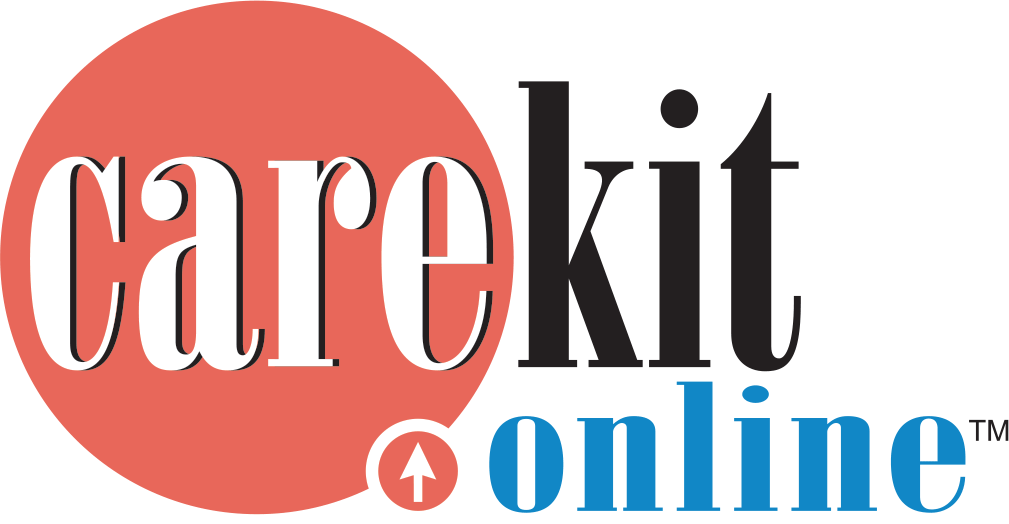How to Evaluate Patient Handout Materials
 Cedars-Sinai Medical Center, despite massive education and motivation campaigns, could not move the rate of doctors’ handwashing above 80%. Finally, they had each doctor press a palm into a Petri dish. Photographs of the results were posted as screensavers on all computers. Handwashing compliance shot up to 100%.
Cedars-Sinai Medical Center, despite massive education and motivation campaigns, could not move the rate of doctors’ handwashing above 80%. Finally, they had each doctor press a palm into a Petri dish. Photographs of the results were posted as screensavers on all computers. Handwashing compliance shot up to 100%.
The purpose of a handout is not education by itself. Of course, it must be clinically correct. Of course, health literacy standards enhance comprehension. But, the purpose of a handout is behavior change.
Handouts change behavior if they meet the Six Standards of communication science:
1) Engage: “The Four-Second Rule”

Advertisers know if a brochure doesn’t capture attention in the first four seconds, the viewer will move on. A handout should also capture attention instantly with:
- An unexpected image or
- Words that arouse curiosity or
- The beginning of a story or
- All of the above
Names like “Healthy Eating” and “Your Guide to Hypertension” are not unexpected. Photos of generic, smiling people do not arouse curiosity. A list of definitions is not a story.
2) Overcome Resistance with Humor
 When an authority says, “Do this,” most people do the opposite. Just the word ‘should’ can spark resistance. A laugh can break the ice.
When an authority says, “Do this,” most people do the opposite. Just the word ‘should’ can spark resistance. A laugh can break the ice.
But The Joint Commission missed the mark on humor: To inspire shy patients to ask doctors questions, The JC concocted a "superhero' character,“SpeakUp!” The patients felt ridiculed rather than inspired.
Humor that humiliates or belittles the patient will create resentment. Humor that allows a patient to laugh at the disease, the situation, anything outside themselves will overcome resistance.
3) Win Compliance with Concrete Answers
 Barbara’s doctor prescribed a Beta Blocker. “What does it block?” she asked. “It’s for your heart,” said the doctor. She asked her nurse, “What does it block?” “It’s for your heart,” said the nurse. “Will it heal my heart?” “No.”
Barbara’s doctor prescribed a Beta Blocker. “What does it block?” she asked. “It’s for your heart,” said the doctor. She asked her nurse, “What does it block?” “It’s for your heart,” said the nurse. “Will it heal my heart?” “No.”
Barbara went home and thought it out. “It doesn’t heal my heart. It blocks something. It must just mask effects. I don’t need that. I won’t take it.”
Too often, trying to be simple, a handout will be vague. If a handout does not give concrete answers, patients will invent their own answers—generally to support a decision to be non-compliant.
How to tell VAGUE information from CONCRETE information:
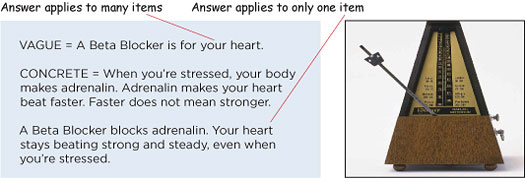
4) Use Adult Memory Links
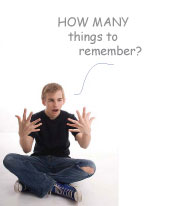 Children can learn by rote repetition. Adult brain cells have changed—they remember if new information connects to familiar concepts. So look for handouts that use metaphors: "What you’re facing now is like a ball game, a recipe, driving a car, playing bridge, etc." Don’t accept handouts that use exotic metaphors like climbing a mountain or entering a space station airlock unless your patients are rapellers and astronauts.
Children can learn by rote repetition. Adult brain cells have changed—they remember if new information connects to familiar concepts. So look for handouts that use metaphors: "What you’re facing now is like a ball game, a recipe, driving a car, playing bridge, etc." Don’t accept handouts that use exotic metaphors like climbing a mountain or entering a space station airlock unless your patients are rapellers and astronauts.
Check if the handout offers help in remembering:
Rhyme, rhythm, alliteration, pattern.
Look for these in the names of a list of tasks.
Watch how long those lists of “To Do” items are!
5) Prioritize Goals
 Professionals are told to set measurable goals for work. Many handouts seem unaware of this rule. They describe topics instead of setting measurable goals. They fail to relate selfcare to any goal—or offer only a vague, unquantified goal: “You’ll feel better.”
Professionals are told to set measurable goals for work. Many handouts seem unaware of this rule. They describe topics instead of setting measurable goals. They fail to relate selfcare to any goal—or offer only a vague, unquantified goal: “You’ll feel better.”
Handouts that don’t change behavior present self-care actions first, then explain why—or neglect to explain why.
Handouts that change behavior
- First state the goal and then
- Explain what selfcare actions accomplish it.
- Tell how to measure progress.
“Your goal is to open up your arteries. You do that by eating good oils and taking an ACE Inhibitor. You'll see progress in lower blood pressure readings.”
Bonus: By breaking up the topics of medication, relating each pill to a different goal, a handout automatically clarifies why a patient must take multiple pills.
How to tell a TOPICAL handout from a GOAL-ORIENTED handout:
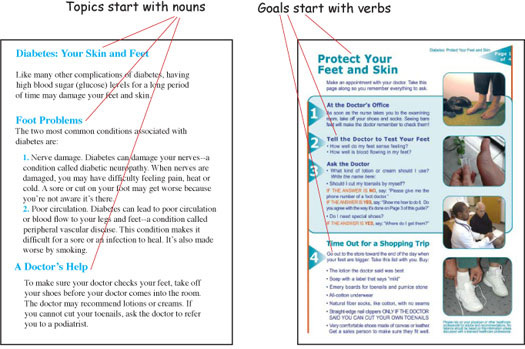
6) Inspire with Powerful Images
 The story of Cedars-Sinai and handwashing is a testimony to the power of images. The doctors did not need more education.
The story of Cedars-Sinai and handwashing is a testimony to the power of images. The doctors did not need more education.
- They knew the facts.
- They did not need greater comprehension.
- They understood the facts.
- They did not need to do a return demonstration.
- They needed to be inspired. Images inspire.
Visual Images
Cutaway diagrams of body parts are a staple of patient handouts. By themselves, however, diagrams rarely inspire. At a glance, which image is more likely to inspire you to exercise and avoid trans fat?
The inside of your artery looks like this.
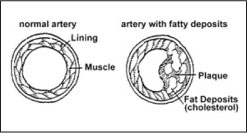

Verbal Images
Telling a story well can conjure up mental images as powerful as photos. Stories can be concrete, moving and memorable. Look for handouts that tell stories: about the disease process, about people with the disease, about how treatments work.
Summary: The Six Standards
Some say, “You can't change behavior with brochures.” But in fact you can if you choose materials that follow the Six Standards of healthcare communication.
- Engage. A surprise in 4 seconds or less
- Overcome Resistance. Laugh at disease
- Win Compliance. Give concrete answers
- Link to Adults. Use rhythm and familiar metaphor
- Prioritize Goals. First ends, then means
- Inspire. Use powerful images in stories
For a demonstration of materials that change behavior, call Communication Science, Toll Free 1-877-CAREKIT
